-
Welcome back Guest! Did you know you can mentor other members here at H-M? If not, please check out our Relaunch of Hobby Machinist Mentoring Program!
You are using an out of date browser. It may not display this or other websites correctly.
You should upgrade or use an alternative browser.
You should upgrade or use an alternative browser.
Restoring a Rockwell/Delta Disc/Belt Finishing Machine
- Thread starter Firestopper
- Start date
- Joined
- May 4, 2015
- Messages
- 3,583
Nice find and a good job on the repairs, I've been watching out for one like that for a year or two. Some think there made of gold the money they want even all apart. Is this model the 3600 rpm or the 1750 . I just don't think I could turn down either one. Good to see the refinishing job is coming along so well. Fun bringing things back to New or better isn't it. Nice pictures too
- Joined
- Nov 7, 2018
- Messages
- 186
Looks awesome, great to see someone putting this much attention into a piece like this - totally worth the effort!
Thank you sir, when completed, this machine should last me the rest of my shop days. The next guy will come out ahead haha. Its lots fun.
Nice find and a good job on the repairs, I've been watching out for one like that for a year or two. Some think there made of gold the money they want even all apart. Is this model the 3600 rpm or the 1750 . I just don't think I could turn down either one. Good to see the refinishing job is coming along so well. Fun bringing things back to New or better isn't it. Nice pictures too
They are getting harder to find, but still available from time to time. The parts are are even scarcer, some folks are fetching more $$$ (per pound) in parts then a complete unit.
As for operating speed, based on the motor PRM's and pulleys size, its a 1750, I had a pretty good idea it was the slower running unit when bidding based on the fact it came out of H.S. wood shop. I'll either change the motor pulley or upgrade the motor to 3 ph and add a VFD for variable speed. I've not decided as of yet and honestly rarely work on wood.
I would appreciate any pros and con on the subject. I can see using it on plastics on occasions.
Thank you fellas
- Joined
- Jun 22, 2012
- Messages
- 1,552
Looking good! Can't wait to see it painted.
- Joined
- Nov 7, 2018
- Messages
- 186
So I got a little shop time after work today and tackled the belt end cover that was grooved through at the lower end. As I mentioned previously, I mig welded it using .035 that was already in the machine as I didn't want to pull the 30 pound spool out and **** off the shoulder. I set the piece up using the corner of the table to keep it as flat as possible and prepped it for welding.
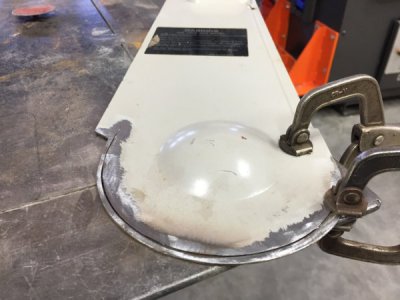
The groove damage was about a .030 gap so using .035 wire took a little focus to keep from burning through and keep distortion at bay.
Here you can see the tac's with good penetration.
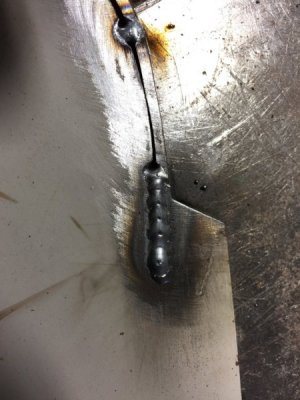
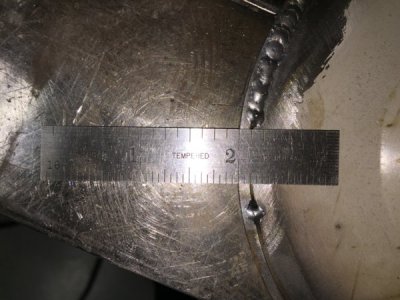
I skipped tacked to keep the heat from melting the edge and control distortion, pausing often to allow cooling until the entire repair was complete.
After cooling, the clamps where removed and I found the penetration was so good I had welded the cover to the table haha. A wooden block was used to protect the edge of the cover and a couple of blows with a small ball peen hammer broke it loose. The table doubled as a heat sink heheh.
Here you can see the penetration on the table where the cover was clamped during welding. The photo shows the underside of the cover.
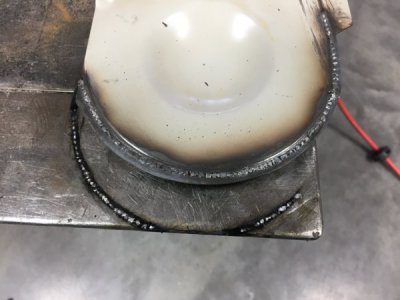
A die grinder with a 2" 50 grit roloc did a fine job feathering and blending the bead down. The take away here is, when feathering a weld, always have a gap to start with or your joint will be weak.
Here a straight edge was used to verify flatness after blending the welds down. A gentle approach with the 50 grit roloc also goes a long way to control distortion and prevent from taking away any parent metal so that you end up with the same thickness of original cover.
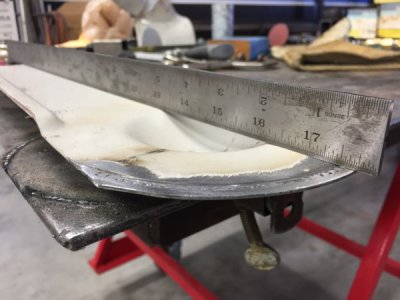
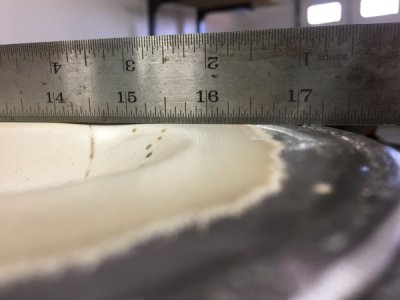
The inside of the cover also had a deep groove about 50% of the thickness, so some 1" welds where done to prevent the cover from possibly cracking from vibration when machine is back in service.
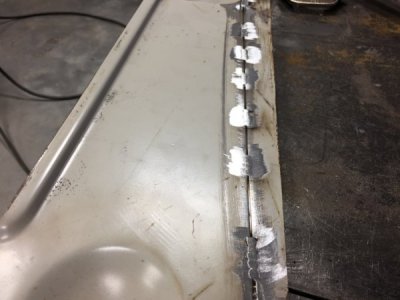
A test fit of the cover to the lower housing where the repair was done shows it sits right in the receiving groove like it should.
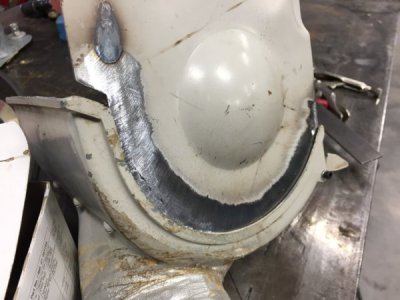
To finish up the repair, some JB quick weld was used to fill in the remaining groove and any irregularities on the inside of cover.
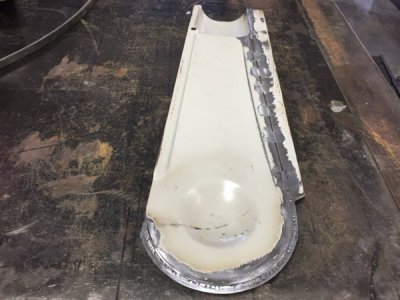
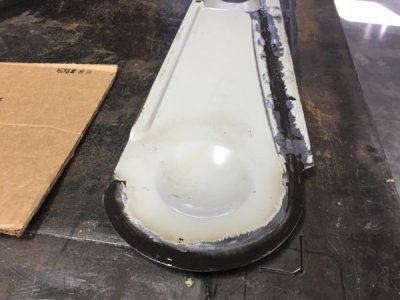
The outside of cover smoothed out fine so no filler required.
Before:
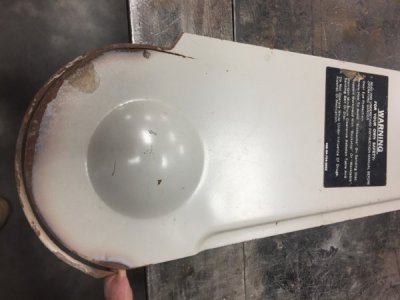
Hammer tone paint will finish this up nicely.
Thats all for now...

The groove damage was about a .030 gap so using .035 wire took a little focus to keep from burning through and keep distortion at bay.
Here you can see the tac's with good penetration.


I skipped tacked to keep the heat from melting the edge and control distortion, pausing often to allow cooling until the entire repair was complete.
After cooling, the clamps where removed and I found the penetration was so good I had welded the cover to the table haha. A wooden block was used to protect the edge of the cover and a couple of blows with a small ball peen hammer broke it loose. The table doubled as a heat sink heheh.
Here you can see the penetration on the table where the cover was clamped during welding. The photo shows the underside of the cover.

A die grinder with a 2" 50 grit roloc did a fine job feathering and blending the bead down. The take away here is, when feathering a weld, always have a gap to start with or your joint will be weak.
Here a straight edge was used to verify flatness after blending the welds down. A gentle approach with the 50 grit roloc also goes a long way to control distortion and prevent from taking away any parent metal so that you end up with the same thickness of original cover.


The inside of the cover also had a deep groove about 50% of the thickness, so some 1" welds where done to prevent the cover from possibly cracking from vibration when machine is back in service.

A test fit of the cover to the lower housing where the repair was done shows it sits right in the receiving groove like it should.

To finish up the repair, some JB quick weld was used to fill in the remaining groove and any irregularities on the inside of cover.


The outside of cover smoothed out fine so no filler required.
Before:

Hammer tone paint will finish this up nicely.
Thats all for now...
- Joined
- Mar 19, 2014
- Messages
- 2,680
You are doing excellent work! And I have one of the same. When you get yours going you will love it! If you didn’t know it. They make thinner jam nuts. My local ACE hardware has them...Dave.
- Joined
- Nov 7, 2018
- Messages
- 186
Thanks Dave,
Hoping for good weather Saturday for painting. Looking forward to getting it in service. I currently have a 12" disc sander that I use often but but the belt should really help out. I went to the largest Ace in Tucson and couldn't find any jamb nuts but the mill made short work of the nyloc nuts. I can't imagine any issues with them coming loose.
What's your opinion on variable speed option for a machine like this?
Hoping for good weather Saturday for painting. Looking forward to getting it in service. I currently have a 12" disc sander that I use often but but the belt should really help out. I went to the largest Ace in Tucson and couldn't find any jamb nuts but the mill made short work of the nyloc nuts. I can't imagine any issues with them coming loose.
What's your opinion on variable speed option for a machine like this?
- Joined
- Jun 22, 2012
- Messages
- 1,552
Coming along very nicely. You questioned variable speed, it depends on what your uses would be. Slower for wood, faster for metal, if your not doing both then choose a speed an leave it. Jmo.
- Joined
- Nov 7, 2018
- Messages
- 186
Well done Paco, you are going to have a very nice machine once it is finished.
Thanks Randy, this was a perfect project for me to ease back into the shop. Still healing from surgery but getting better every day.
Coming along very nicely. You questioned variable speed, it depends on what your uses would be. Slower for wood, faster for metal, if your not doing both then choose a speed an leave it. Jmo.
Thanks for the advice on the variable speed option. Probably just replace the motor pulley for more RPM's. I rarely work with wood.

